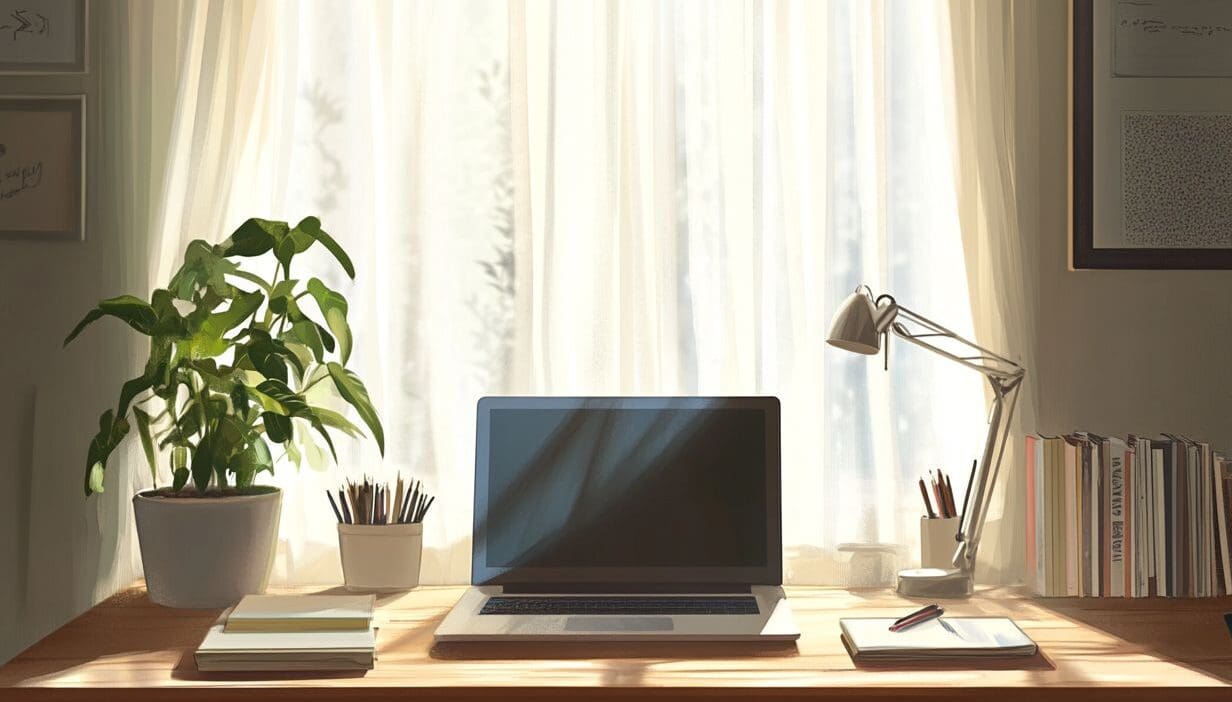In a world characterized by constant notifications, communication, and visual stimuli, maintaining focus can often prove to be a significant challenge. This article examines the importance of cultivating a distraction-free environment, offering productivity tips that enhance focus and concentration. It will address the effects of distractions and provide insights into the design of a dedicated workspace, offering practical strategies to minimize interruptions. Additionally, the discussion will encompass how technology can be effectively utilized to improve focus, along with the necessity of establishing a routine that supports sustained concentration. Prepare to transform your workspace and unlock your full potential.
Key Takeaways:
The Importance of a Focus-Friendly Environment
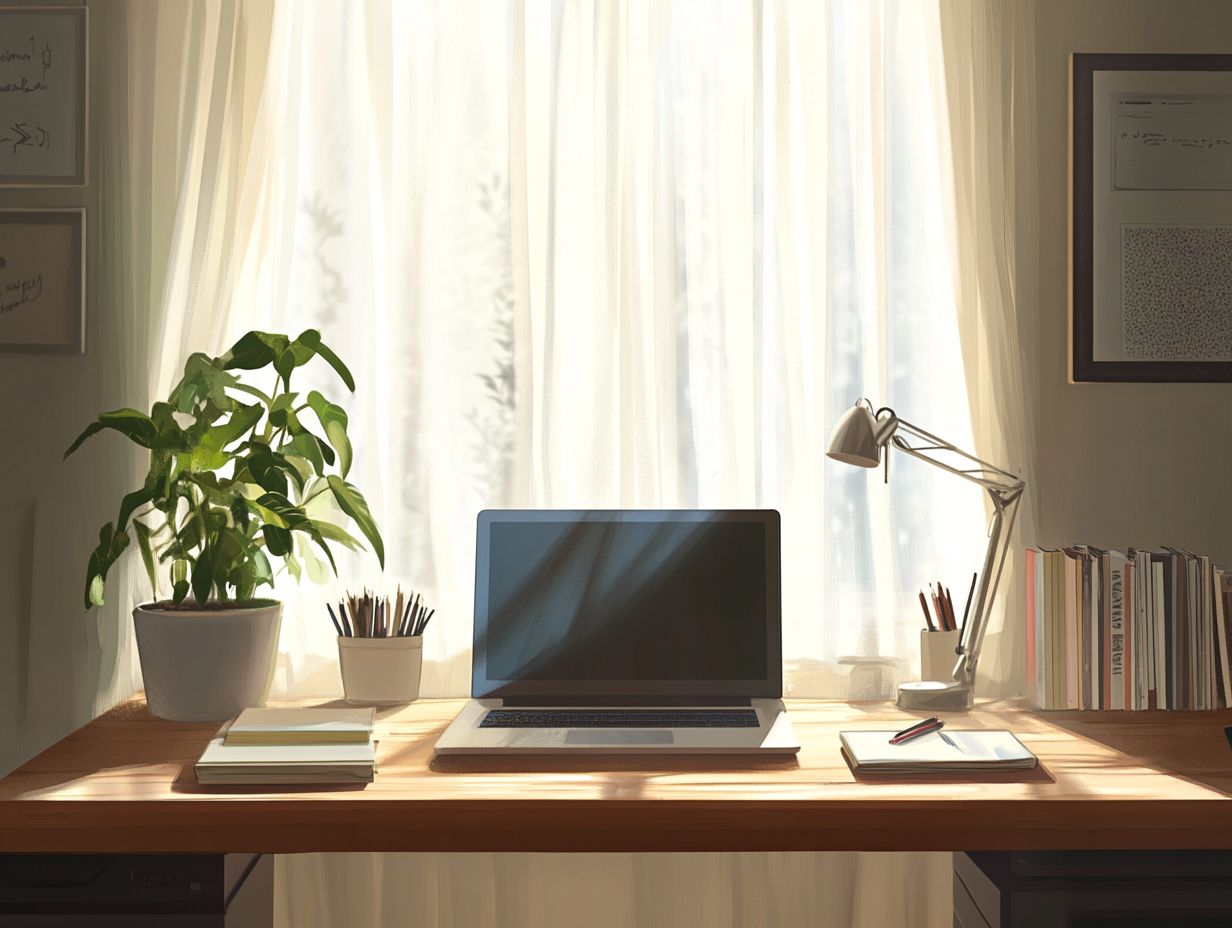
Establishing a focus-friendly environment is essential for enhancing productivity and promoting personal wellness, particularly for individuals working from a dedicated home office.
A thoughtfully designed home office or workspace that minimizes distractions and encourages physical separation can have a significant effect on an individual’s ability to maintain a productive daily routine, benefiting from smart technology and ergonomic furniture.
By incorporating key elements such as ergonomic furniture, effective noise management strategies, and a calming atmosphere, individuals can foster a sense of comfort and well-being.
This conducive environment enables better concentration on tasks and facilitates the achievement of a healthy work-life balance.
Effects of Distractions on Productivity
Distractions can significantly impede productivity, negatively impacting focus and concentration within a workspace organization and home environment. Digital distractions, such as notifications from platforms like Slack or social media, can disrupt the workflow and result in inefficiencies. Therefore, it is essential to develop strategies aimed at minimizing their impact.
Not only digital disturbances disrupt concentration, but environmental factors such as loud conversations, construction noises, or even ambient music can also divert attention. For individuals striving to improve their work-life balance, it is crucial to recognize these various forms of distractions. In fact, according to Harvard Business Review, conquering digital distractions is vital for maintaining focus in the modern workplace.
Implementing productivity strategies, such as establishing designated ‘do not disturb’ hours or creating a dedicated workspace, can considerably reduce interruptions. Additionally, employing noise management techniques, such as using noise-canceling headphones or playing ambient sounds, can foster an environment conducive to focused work.
By actively managing both digital and environmental distractions, individuals can cultivate a more harmonious and efficient workspace, ultimately enhancing productivity and achieving a more satisfying work-life balance.
Designing a Distraction-Free Space
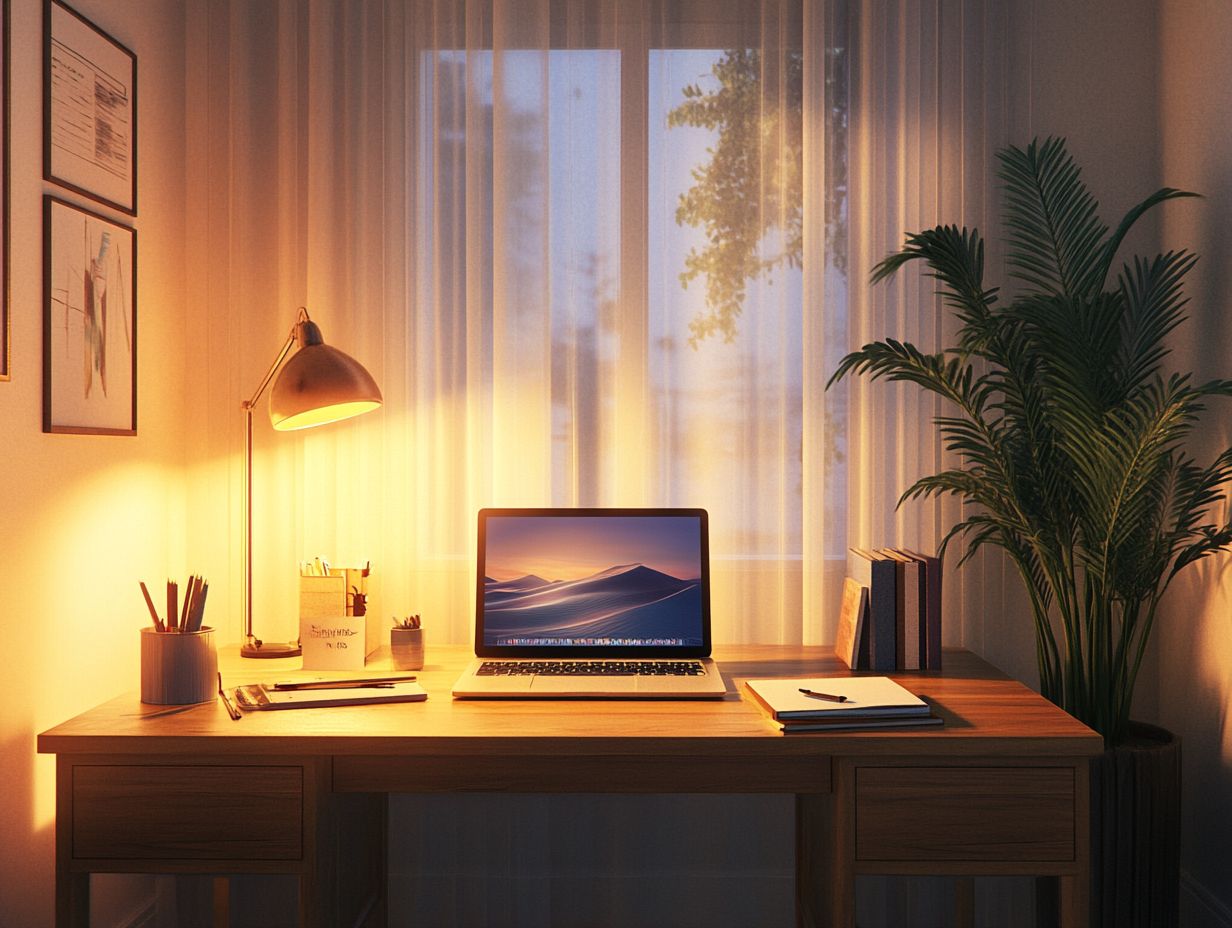
Designing a distraction-free environment is essential for enhancing productivity in a home office, incorporating lighting design and workspace decor.
Implementing appropriate lighting design, combined with ergonomic furniture and effective workspace organization, can establish an environment that minimizes distractions and promotes concentration. According to the Mayo Clinic’s guide on office ergonomics, prioritizing ergonomic solutions can significantly enhance comfort and efficiency in a workspace.
By integrating elements that cultivate a calming atmosphere, individuals can optimize their home office for improved work efficiency.
Creating a Dedicated Workspace
Establishing a dedicated workspace within the home is a crucial step toward enhancing productivity and focus. By physically separating professional responsibilities from personal activities, individuals can create a clear boundary that promotes a more effective work environment.
This separation not only helps to define work hours but also minimizes distractions that may infiltrate one’s personal space. For instance, designating a specific room or corner of the house as an office can signal to the brain that it is time to enter work mode upon entering that area.
To further enhance this experience, incorporating organizational techniques such as:
- Regular decluttering,
- Utilizing effective storage solutions,
- Maintaining an inspiring décor
can significantly increase motivation. Productivity strategies like time blocking, which involves allocating specific hours for particular tasks, become more manageable when a dedicated workspace is in place. This intentional approach ultimately leads to improved focus, greater efficiency, and a more satisfying working experience.
Minimizing Visual and Auditory Distractions
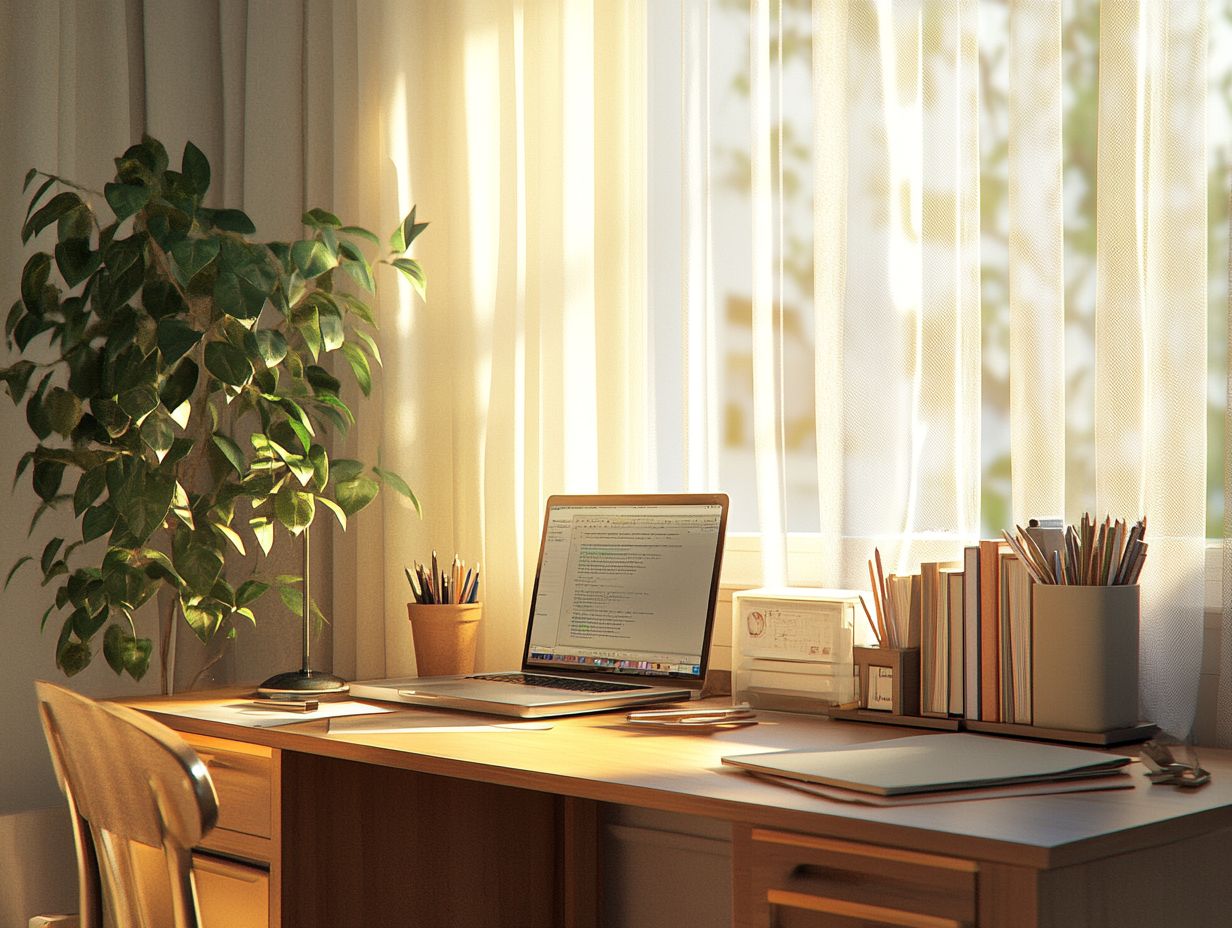
Minimizing visual and auditory distractions is critical for maintaining focus and concentration in a home office environment. Implementing strategies such as utilizing noise-canceling headphones and organizing workspace decor can significantly reduce interruptions, thereby fostering a more conducive atmosphere for productivity. According to research published in ScienceDirect, active noise-cancelling headphones are effective in enhancing concentration by reducing ambient noise, making them an optimal choice for home offices.
Plus these tools, individuals may consider the advantages of sound absorption panels or white noise machines, which effectively assist in masking background noise.
Strategically decluttering workspaces and ensuring that essential items are readily accessible can enhance efficiency and mitigate the need for constant visual scanning.
Establishing a designated work area, removed from common household distractions, facilitates a clearer mental separation between personal and professional responsibilities.
Furthermore, incorporating calming colors, Spider Plant, Snake Plant, and indoor plants can contribute to a visually appealing environment that promotes tranquility, making it easier to maintain focus on the tasks at hand.
Utilizing Technology to Enhance Focus
The utilization of technology to enhance focus can significantly transform the productivity of individuals operating within a home office setting.
Integrating smart technology, such as the Hubitat system, facilitates the establishment of automated schedules, task lighting, and temperature control that can be adjusted according to user preferences.
This approach effectively minimizes digital distractions and fosters a more conducive work environment for sustained focus and efficiency.
Productivity Apps and Tools
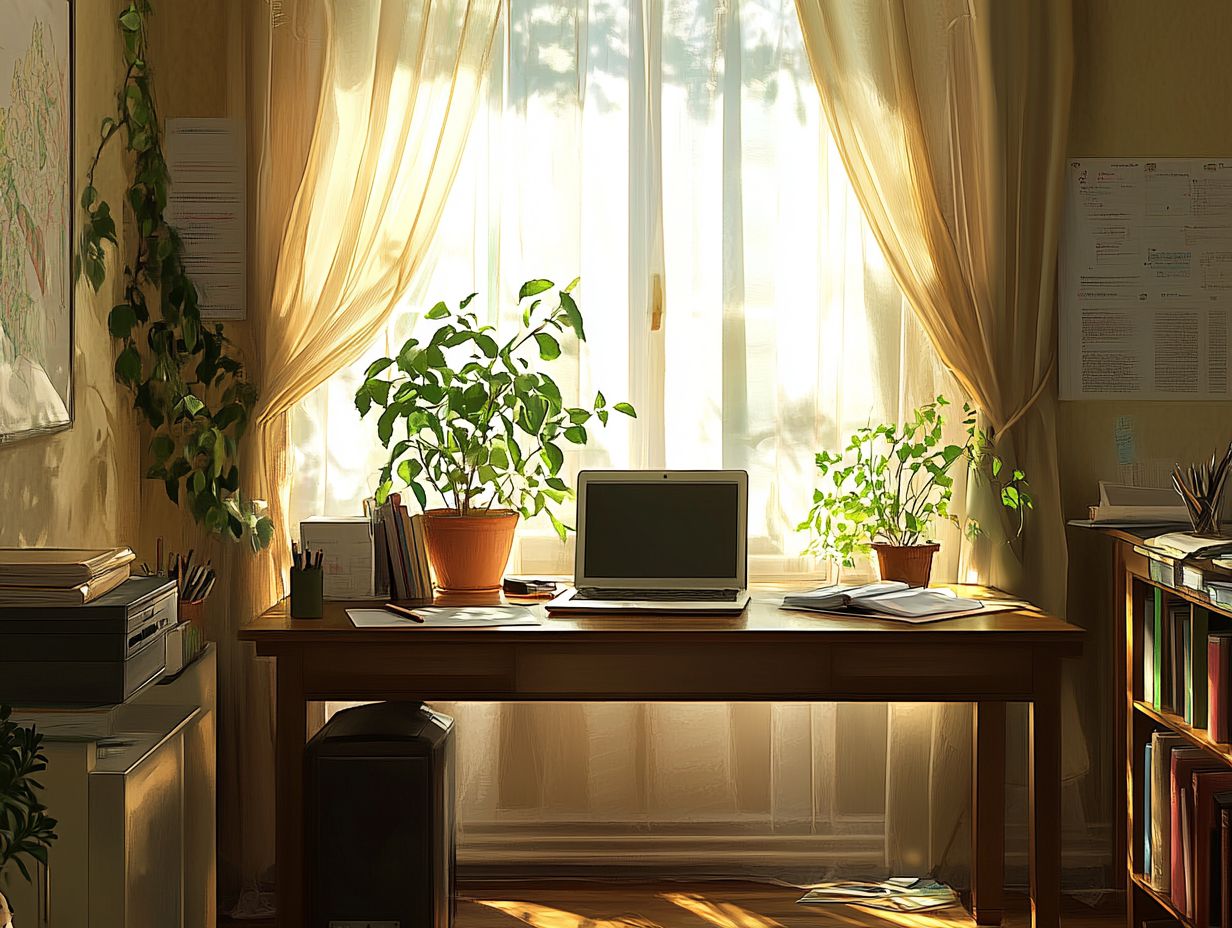
Productivity applications and tools significantly contribute to fostering a focus-friendly environment, improving strategies and creativity prompts for remote workers. Tools such as Google Drive, Dropbox, Evernote, and OneNote can streamline workflows, improve organizational capabilities, and reduce the time allocated to administrative tasks.
By employing these tools, individuals can effectively manage documents, collaborate effortlessly with team members, and maintain a well-organized digital workspace that promotes creativity, positive reinforcement, and concentration.
For example, Google Drive facilitates easy sharing and real-time collaboration, ensuring that all team members remain aligned without the complications of lengthy email exchanges. Similarly, Evernote provides distinctive features for note-taking and task management, enabling users to transform fragmented thoughts into actionable plans.
Task tracking programs like Trello or Asana enable users to prioritize responsibilities, thereby minimizing distractions and encouraging a more structured approach to daily activities.
In this manner, the appropriate selection and combination of productivity applications can substantially enhance both focus and efficiency within any workspace.
Setting Boundaries with Technology
Establishing boundaries with technology is essential for maintaining a productive work-life balance, incorporating relaxation zones and virtual connection.
By implementing guidelines for the use of devices and applications, individuals can significantly reduce digital distractions and create a more structured workflow.
One effective strategy is to define specific work hours during which notifications are muted, and personal applications are restricted. This approach facilitates deeper concentration and diminishes the temptation to engage with social media or non-work-related applications that can rapidly consume time.
Additionally, integrating app usage limits can enhance attention spans and decrease the compulsion to constantly check for updates. To further promote productivity, it is advisable to designate specific tech-free zones or times throughout the day.
During these periods, individuals can reflect or participate in offline activities, which aids in recharging and sustaining motivation without the constant distraction of devices.
Establishing a Routine for Optimal Focus
Establishing a structured routine for optimal focus is crucial for enhancing productivity and sustaining healthy work habits.
Implementing daily routines that incorporate scheduled break reminders, active breaks, and routine automation can substantially improve concentration and overall well-being, enabling individuals to remain engaged and energized throughout their workday.
Creating a Schedule and Sticking to It
Establishing a schedule and adhering to it can significantly enhance focus and concentration within a professional environment. By implementing a structured daily routine, individuals are better positioned to prioritize tasks and allocate time effectively, resulting in improved productivity.
Incorporating techniques such as time blocking—designating specific periods for concentrated work—can help minimize distractions and maximize output. Additionally, employing productivity strategies such as setting clear deadlines and breaking larger projects into manageable tasks fosters a sense of accomplishment.
The automation of routines through digital tools and applications, like Slack, Asana, and Trello, can streamline the scheduling process, ensuring that critical tasks, stored in Google Drive and Dropbox, are not overlooked. A well-constructed schedule not only increases efficiency but also reduces stress levels, fostering a productive workspace and allowing individuals to feel more in control and engaged in their work.
Incorporating Breaks and Mindfulness Practices
Incorporating breaks and mindfulness practices into the work routine is essential for personal wellness and sustained productivity. Scheduled active breaks and designated relaxation zones can rejuvenate both the mind and body, enhancing overall focus, clutter reduction, and efficiency.
These brief interludes provide an opportunity for individuals, in a comfortable workspace, to reset, allowing them to step away from their screens and engage in activities, such as educational games and family activities, that promote mental clarity. Mindfulness techniques such as meditation or light stretching can significantly alleviate stress, enabling individuals to return to their tasks with a clearer perspective and heightened creativity.
Integrating these wellness practices into daily life encourages a healthier work-life balance and significantly reduces the risk of burnout. Ultimately, the modest investment of time in these practices yields substantial benefits in terms of improved concentration, acoustic panels, natural light benefits, and a more positive outlook on both professional and personal endeavors.
